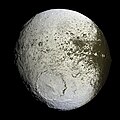
Sınaq göstərişi ölçüsü: 600 × 600 piksel. Digər ölçülər: 240 × 240 piksel | 480 × 480 piksel | 768 × 768 piksel | 1.024 × 1.024 piksel | 2.048 × 2.048 piksel | 4.032 × 4.032 piksel.
Faylın orijinalı (4.032 × 4.032 piksel, fayl həcmi: 6,22 MB, MIME növü: image/jpeg)
Faylın tarixçəsi
Faylın əvvəlki versiyasını görmək üçün gün/tarix bölməsindəki tarixlərə klikləyin.
| Tarix/Vaxt | Miniatür | Ölçülər | İstifadəçi | Şərh | |
|---|---|---|---|---|---|
| hal-hazırkı | 18:07, 12 dekabr 2018 |  | 4.032 × 4.032 (6,22 MB) | Kesäperuna | 100% JPEG quality from full quality TIFF, slightly cropped to be more centered. |
| 09:18, 9 oktyabr 2007 |  | 4.100 × 4.100 (1,56 MB) | Startaq | {{Information |Description = Cassini captures the first high-resolution glimpse of the bright trailing hemisphere of Saturn's moon Iapetus. This false-color mosaic shows the entire hemisphere of Iapetus (1,468 kilometers, or 912 miles across) visible fro |
Faylın istifadəsi
Aşağıdakı səhifə bu faylı istifadə edir:
Faylın qlobal istifadəsi
Bu fayl aşağıdakı vikilərdə istifadə olunur:
- af.wikipedia.org layihəsində istifadəsi
- an.wikipedia.org layihəsində istifadəsi
- ar.wikipedia.org layihəsində istifadəsi
- إيابيتوس (قمر)
- قالب:المجموعة الشمسية
- قائمة أجرام المجموعة الشمسية مرتبة حسب الحجم
- ويكيبيديا:صورة اليوم المختارة/فبراير 2015
- قالب:صورة اليوم المختارة/2015-02-01
- اكتشاف واستكشاف النظام الشمسي
- قائمة أنواع الكواكب
- بوابة:زحل/مقالة مختارة وصورة لأحد أقمار زحل
- مستخدم:ASammour/صور مختارة
- قائمة أكبر الفوهات في المجموعة الشمسية
- 1981 ميداس
- ary.wikipedia.org layihəsində istifadəsi
- arz.wikipedia.org layihəsində istifadəsi
- ast.wikipedia.org layihəsində istifadəsi
- ba.wikipedia.org layihəsində istifadəsi
- be.wikipedia.org layihəsində istifadəsi
- bg.wikipedia.org layihəsində istifadəsi
- bn.wikipedia.org layihəsində istifadəsi
- bn.wikibooks.org layihəsində istifadəsi
- bs.wikipedia.org layihəsində istifadəsi
- ca.wikipedia.org layihəsində istifadəsi
- ckb.wikipedia.org layihəsində istifadəsi
- cs.wikipedia.org layihəsində istifadəsi
Bu faylın qlobal istifadəsinə baxın.

